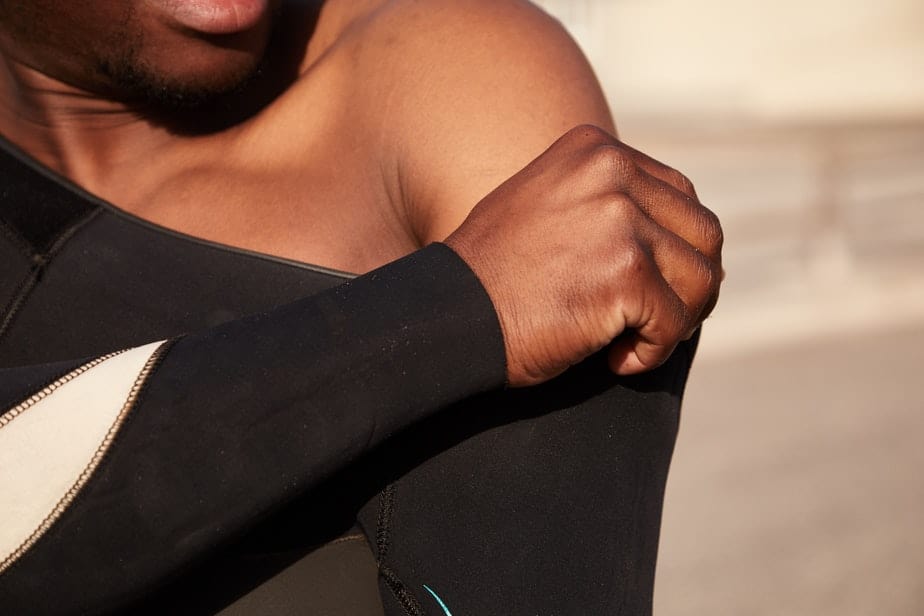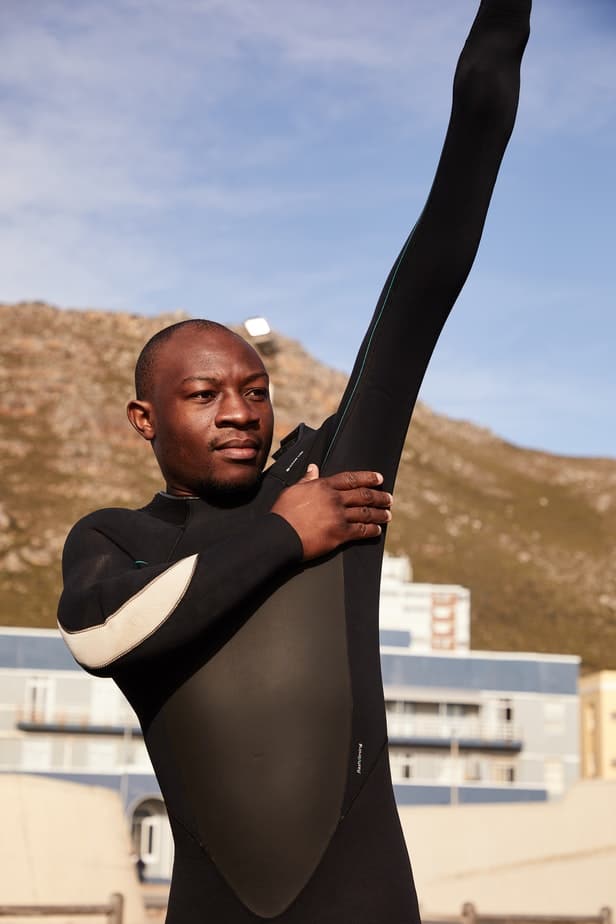Wetsuits are designed to keep you warm in the water, but how does it accomplish that? Most people guess that wetsuits do so by keeping you dry, but that isn’t the case. Wetsuits are actually designed to insulate your body heat, and it can do that even if you’re wet. While the neoprene material a wetsuit is made of is waterproof, water can enter through the neck, wrists, ankles and zippers. Whatever you wear under a wetsuit will get wet, but you’ll be warm!
If cold water is able to enter the wetsuit then how is it able to keep wearers warm? Keep in mind, only a thin layer of water can get underneath the suit; wetsuits are intended to be very tight and form-fitting. Since the water is so close to your body, it gets warmed up by your body heat, creating an insulating layer of water within the suit.
Additionally, you may be getting wetsuits confused with drysuits which actually do keep you dry. In case you get the names mixed up, here’s a tip: “wet-suits” let you get wet, “dry-suits” keep you dry.
Are wetsuits waterproof?
The neoprene material that wetsuits are made of are waterproof, however wetsuits will not keep you dry and whatever you wear underneath will get drenched. This sounds like a contradiction, but allow us to explain.
For instance, if you are wearing dry clothes underneath your wetsuit and someone splashes you with a bucket of water, your undergarments will remain completely dry. The inner layer of a wetsuit is waterproof and doesn’t let water pass through it. However, water can enter the wetsuit through the wrists, ankles, neck, and zipper when you are completely submerged. This is also the reason why wetsuits cannot be used for ice diving.
You can wear just swim trunks or a bikini underneath a wetsuit, or you can wear a rash vest underneath for privacy or extra warmth. Since wetsuits are so tight already, not everyone likes to wear extra layers beneath.
If you do decide to wear something inside, it should not be too bulky or water-absorbent. Whatever you wear is going to get drenched which can make you colder, can bunch up which is uncomfortable and shows up as unflattering bumps, and can weigh you down when soaked which is restricting.
How does water enter the wetsuit?
Wetsuits are constructed from closed-cell neoprene foam which is waterproof and a great insulating material. Tiny nitrogen bubbles can be found inside the neoprene material. It’s actually these nitrogen bubbles that trap heat and keep you warm. The bubbles also make the wetsuit extremely buoyant.
If neoprene is waterproof, how does water get inside you may be asking. Basically, anywhere there is an opening, such as the neck, wrists, ankle, and zipper areas, water can seep in. Since a wetsuit is so tight, only a little bit of water can enter, and this water gets warmed up by the heat trapped inside the wetsuit.
As we mentioned, since the wetsuit is waterproof, water can’t penetrate through the suit and this also implies that water can’t get out except through the aforementioned openings. That means that only a little bit of cold water is entering and a little bit of warm water is escaping, but overall the thin layer of water inside the suit is warm.
In a high-quality wetsuit, very little warm water will be lost and very little cold water will enter, so the net effect is that you’re still mostly warm. In a low-quality wetsuit that isn’t form-fitting, more water will flow through (this is known as the flush) than your body can warm up, causing you to be cold overall.
Since the openings of the wetsuit are not watertight, water will enter when submerged. The insulating effect of the neoprene material will trap the body heat which warms up the water. This process is only possible if the wetsuit is tight enough so that most of the warm water is retained.
Do you need to be wet to be warm in a wetsuit?
It’s a myth that wetsuits need water to enter and form a thin layer inside and get heated up in order to keep you warm. This is not the case at all and in fact, a wetsuit will keep you warmer if it keeps you completely dry. But then it wouldn’t be a wetsuit, it’d be a drysuit.
As we mentioned, the neoprene foam that wetsuits are made of contains nitrogen bubbles. These bubbles are insulating, meaning it traps the body heat and keeps it from getting lost to the cold water. The thin layer of warm water is actually just a byproduct of being trapped between your skin and the insulating neoprene material, and it is not the main reason for why wetsuits keep you warm.
To test just how effective wetsuits are at keeping you warm, try standing in the sun with your wetsuit on a hot day and it’ll feel like you’re boiling inside. Actually, if you’re worried about how cold the water will feel when it initially enters the wetsuit, just keep the wetsuit on in the sun for a while until you feel like you’re cooking inside, and then the cold water will provide a sense of relief instead.
How tight should a wetsuit fit?

In order for a wetsuit to be effective, it needs to fit you a certain way. It needs to strike a balance between snug, but not too tight as to be restrictive. Around the neck and cuffs (ankles and wrists), a wetsuit should be close-fitting so that minimal water can flow in. Too loose, and cold water will constantly flush out the warm water.
To give you an idea of how tight a wetsuit should be, let’s just say that it displays the shape of your body in a very revealing way. Many people often describe a wetsuit as a “second-skin” for your water activities. Hopefully you’re not shy.
The thicker the wetsuit, the more restrictive it will be. However, it should not be so tight that it puts undue stress on the seams, or rips around the underarms and lower back. You should be able to move your arms and legs relatively freely. A wetsuit should not restrict your blood circulation.
Conversely, if a wetsuit is too loose, it is completely useless. It would not be able to insulate any heat, and the cold water will constantly sap your warmth. Water will be flowing in and out of your suit even if it is tight. However, in a form-fitting wetsuit, the rate at which this happens is slow, and you will still feel mostly warm. Loose wetsuits also increase drag underwater, and are cumbersome to wear on the surface.
Different wetsuit designs
Regardless of the wetsuit design, all of them will not keep you from getting wet. However, the exposed areas will not be insulated when exposed to the water. Each one has different uses, but all of them are made from neoprene and are intended to keep you insulated.
Shorty wetsuits
Shorties have short leggings and sleeves. Since your arms and legs are partially exposed, you have more freedom of movement and will feel cooler. Shorty wetsuits are ideal for warm water activities such as snorkeling and kitesurfing.
Full-length wetsuits
A full-length wetsuit covers most of your body, with the exception of your head, hands, and feet. The only parts that are exposed are your hands, feet, and head. They are ideal for use in temperate waters, and are often worn with diving gloves, dive booties, and a dive hood which covers up the exposed areas that a full-length wetsuit doesn’t. Even with all of this equipment, you will still get wet. Their primary purpose is insulation, not keeping you dry.
Vest and swimwear
For shallow dives and very warm waters, an alternative to shorty wetsuits is to simply wear swim trunks/bikini paired with a dive vest. A full wetsuit and even a shorty wetsuit isn’t required.
Can you make a wetsuit waterproof?
You could theoretically make a wetsuit fully waterproof by sealing off the openings with rubber cuffs, however this is not how they are designed. Wetsuits have varying thicknesses, and most wetsuits are actually intended to be worn in warm water.
Thus, it’s not so much a concern if water enters the wetsuit since it’s not cold enough to cause hypothermia. If you do plan on diving in cold temperatures, then you wouldn’t be using a wetsuit; you’d just wear a drysuit instead.
Let’s examine how drysuits are designed in comparison. The openings of a drysuit are sealed with thick rubber cuffs to keep water out. However, drysuits are baggier and the extra space inside is intended for wearers to wear warm clothes underneath.
The warmth provided when wearing a drysuit is from the insulating effect of the clothes underneath, and not the drysuit. With that said, some drysuits do use insulating foam in addition to being waterproof to keep you extra insulated.
Then there are also semi-dry wetsuits which have thick rubber cuffs that only let in a little bit of water, far less than a regular wetsuit.
Do wetsuits stretch when wet?

Once they are wet, a wetsuit stretches and conforms to your body. A higher-quality wetsuit will be more durable and will stretch which makes it more comfortable to wear and easier to move in. Actually, it’s not the neoprene that stretches when wet, but the fabric that loosens up and gives you more flexibility.
If you’re having trouble putting on a wetsuit, make sure you are both dry, or both wet. If you try to wear a wet wetsuit when dry, or a dry wetsuit when wet, you will find it incredibly difficult because of the friction this causes. Do not pull so hard on a wetsuit to try to stretch it over your body.
Parting Words
So, do wetsuits keep you dry? No. They keep you warm in spite of being wet. Whatever you wear underneath a wetsuit will also get wet. The nitrogen bubbles in the wetsuit are good at insulating your body heat and that is how you stay warm. The water that enters the wetsuit will get warmed up by your body heat and limits the amount of cold water that enters the suit.
Since there are numerous wetsuit variations, thicknesses, and designs, make sure you consider the temperature and conditions that you will be using a wetsuit in. Wetsuits are an extremely important piece of equipment for keeping you warm during any water activity!


